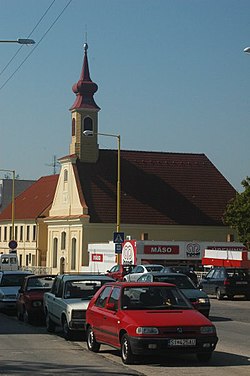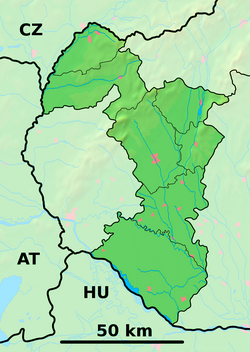Holíč
Holíč | |
|---|---|
Town | |
 A Lutheran church in Holíč | |
Location of Holíč in the Trnava Region | |
| Coordinates: 48°48′44″N 17°09′38″E / 48.81222°N 17.16056°E | |
| Country | Slovakia |
| Region | Trnava |
| District | Skalica |
| First mentioned | 1208 |
| Government | |
| • Mayor | Zdenko Čambal |
| Area | |
• Total | 34.79 km2 (13.43 sq mi) |
| (2022) | |
| Elevation | 180[2] m (590[2] ft) |
| Population | |
• Total | 11,024 |
| • Density | 320/km2 (820/sq mi) |
| Time zone | UTC+1 (CET) |
| • Summer (DST) | UTC+2 (CEST) |
| Area code | +421 34[2] |
| Car plate | SI |
| Website | www.holic.sk |
Holíč (until 1946 "Holič", German: Weißkirchen (an der March) / Holitsch, Hungarian: Holics) is a town in western Slovakia.
History
[edit]The oldest archaeological findings in the area date from the Neolithic, and there are findings from the Bronze Age, Iron Age and the Roman time. The town was first mentioned in 1205 as Wywar, meaning "New Castle". The Árpád dynasty built a stone castle after the Mongol invasion in 1241. From the 13th century until 1296, Holíč was the seat of a border comitatus. Among the owners of the town were Matthias Csák and Stibor of Stiborice. In the 15th century the town's development was slowed by the Hussite raids. In 1736 the town was bought by Franz I, Holy Roman Emperor, husband of Maria Theresa and manufactures were built, leading to the town's growth. Maria Theresa also rebuilt the Holíč Castle from a fortress into a summer château of the Habsburgs. Holíč's once thriving Jewish community was completely decimated by the Holocaust.
Holíč also gives its name to a type of tin-glazed earthenware faience that was manufactured in the area. The Holitsch factory (Slovakia) was founded in 1743 by Francis of Lorainne, consort of Empress Maria Teresia. The factory concentrated on the production of richly adorned sets intended to emulate the wares used by the aristocracy in the large western European centers. The factory, which served as a revitalizing force against the decline of local potters in the 18th century, brought together experts from different countries in a co-operative effort to produce wares from which later central European factories derived their inspiration. Responding to an eager market and following patterns established at the Strasbourg factory, the Holitsch factory produced remarkably life-like pieces imitating fruits and vegetables. These fine examples of modeling were further distinguished by the brightness of the colors used in their decorations. The potters also created sculpture vessels of human or animal shapes that were intended for a practical as well as decorative use such as salt dishes, parrot bottles, and lidded containers.
In August 1942, President Jozef Tiso gave an infamous speech in the town in which he defended the deportation of Jews from Slovakia, because they were "parasites".
Geography
[edit]Holíč lies at an altitude of 185 metres (607 ft) above sea level and covers an area of 34.784 square kilometres (13.4 sq mi).[4] It is located in the Záhorie region near the Morava River, 6 kilometres (4 mi) away from the Czech city of Hodonín and around 85 kilometres (53 mi) from Bratislava.
Sights
[edit]- Holíč Castle, now a baroque château
- Gothic church from 1387
- Capuchin church from 1755
- Tolerantion church from 1787
- Burgher house, originally in Baroque, now in Art Nouveau style
- Complex of manufacture buildings
- Water and wind mills
- Loretan and Florian chapels
In the neighbouring village of Kopčany, the 9th century St. Margaret's Church from the time of Great Moravia, is located.
Demographics
[edit]| Year | Pop. | ±% |
|---|---|---|
| 1970 | 7,570 | — |
| 1980 | 8,741 | +15.5% |
| 1991 | 11,359 | +30.0% |
| 2001 | 11,416 | +0.5% |
| 2011 | 11,255 | −1.4% |
| 2021 | 11,214 | −0.4% |
| Source: Censuses[5][6] | ||
According to the 2001 census, the town had 11,416 inhabitants. 93.82% of inhabitants were Slovaks, 3.68% Czechs, 0.99% Roma and 0.48% Ukrainians.[4] The religious make-up was 66.36% Roman Catholics, 23.20% people with no religious affiliation and 6.04% Lutherans.[4]
Twin towns — sister cities
[edit]See also
[edit]References
[edit]- ^ Statistical Office of the Slovak Republic (www.statistics.sk). "Hustota obyvateľstva - obce". www.statistics.sk. Retrieved 2024-02-08.
- ^ a b c d "Základná charakteristika". www.statistics.sk (in Slovak). Statistical Office of the Slovak Republic. 2015-04-17. Retrieved 2022-03-31.
- ^ Statistical Office of the Slovak Republic (www.statistics.sk). "Počet obyvateľov podľa pohlavia - obce (ročne)". www.statistics.sk. Retrieved 2024-02-08.
- ^ a b c "Municipal Statistics". Statistical Office of the Slovak republic. Archived from the original on 2008-01-11. Retrieved 2008-02-07.
- ^ "Statistical lexikon of municipalities 1970-2011" (PDF) (in Slovak).
- ^ "Census 2021 - Population - Basic results". Statistical Office of the Slovak Republic. 2021-01-01.
- ^ "Úvodná strana". holic.sk (in Slovak). Holíč. Retrieved 2019-09-08.
Genealogical resources
[edit]The records for genealogical research are available at the state archive "Statny Archiv in Bratislava, Slovakia"
- Roman Catholic church records (births/marriages/deaths): 1678–1922 (parish A)
- Lutheran church records (births/marriages/deaths): 1786–1895 (parish A)
External links
[edit]![]() Media related to Holíč at Wikimedia Commons
Media related to Holíč at Wikimedia Commons



